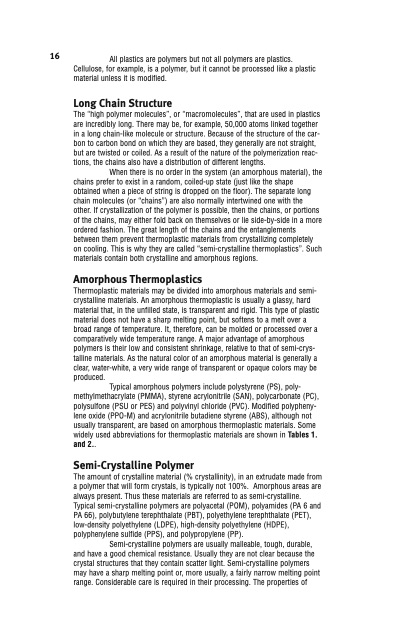
PDF Publication Title:
Text from PDF Page: 022
16 All plastics are polymers but not all polymers are plastics. Cellulose, for example, is a polymer, but it cannot be processed like a plastic material unless it is modified. Long Chain Structure The “high polymer molecules”, or “macromolecules”, that are used in plastics are incredibly long. There may be, for example, 50,000 atoms linked together in a long chain-like molecule or structure. Because of the structure of the car- bon to carbon bond on which they are based, they generally are not straight, but are twisted or coiled. As a result of the nature of the polymerization reac- tions, the chains also have a distribution of different lengths. When there is no order in the system (an amorphous material), the chains prefer to exist in a random, coiled-up state (just like the shape obtained when a piece of string is dropped on the floor). The separate long chain molecules (or “chains”) are also normally intertwined one with the other. If crystallization of the polymer is possible, then the chains, or portions of the chains, may either fold back on themselves or lie side-by-side in a more ordered fashion. The great length of the chains and the entanglements between them prevent thermoplastic materials from crystallizing completely on cooling. This is why they are called “semi-crystalline thermoplastics”. Such materials contain both crystalline and amorphous regions. Amorphous Thermoplastics Thermoplastic materials may be divided into amorphous materials and semi- crystalline materials. An amorphous thermoplastic is usually a glassy, hard material that, in the unfilled state, is transparent and rigid. This type of plastic material does not have a sharp melting point, but softens to a melt over a broad range of temperature. It, therefore, can be molded or processed over a comparatively wide temperature range. A major advantage of amorphous polymers is their low and consistent shrinkage, relative to that of semi-crys- talline materials. As the natural color of an amorphous material is generally a clear, water-white, a very wide range of transparent or opaque colors may be produced. Typical amorphous polymers include polystyrene (PS), poly- methylmethacrylate (PMMA), styrene acrylonitrile (SAN), polycarbonate (PC), polysulfone (PSU or PES) and polyvinyl chloride (PVC). Modified polypheny- lene oxide (PPO-M) and acrylonitrile butadiene styrene (ABS), although not usually transparent, are based on amorphous thermoplastic materials. Some widely used abbreviations for thermoplastic materials are shown in Tables 1. and 2.. Semi-Crystalline Polymer The amount of crystalline material (% crystallinity), in an extrudate made from a polymer that will form crystals, is typically not 100%. Amorphous areas are always present. Thus these materials are referred to as semi-crystalline. Typical semi-crystalline polymers are polyacetal (POM), polyamides (PA 6 and PA 66), polybutylene terephthalate (PBT), polyethylene terephthalate (PET), low-density polyethylene (LDPE), high-density polyethylene (HDPE), polyphenylene sulfide (PPS), and polypropylene (PP). Semi-crystalline polymers are usually malleable, tough, durable, and have a good chemical resistance. Usually they are not clear because the crystal structures that they contain scatter light. Semi-crystalline polymers may have a sharp melting point or, more usually, a fairly narrow melting point range. Considerable care is required in their processing. The properties ofPDF Image | Dynisco Extrusion Processors Handbook

PDF Search Title:
Dynisco Extrusion Processors HandbookOriginal File Name Searched:
27429_Legacy_Txt.pdfDIY PDF Search: Google It | Yahoo | Bing
Development of a solar powered Electric Ship The Electricship website originally started off as a project to develop a comprehensive renewable, affordable, modular electric ship... More Info
Modular Boat Hull Composite The case for a unsinkable, modular composite hybrid boat hull... More Info
MS Burgenstock Hybrid Electric Catamaran Lake Lucerne Unique shuttle servicing Lucerne to the Burgenstock Resort... More Info
Ground Power Unit GPU Powered by Lithium Ion Batteries The goal of the Ground Power Unit is to provide a readily accessible, modular, ready-to-power solution for remote power... More Info
| CONTACT TEL: 608-238-6001 Email: greg@electricship.com | RSS | AMP |